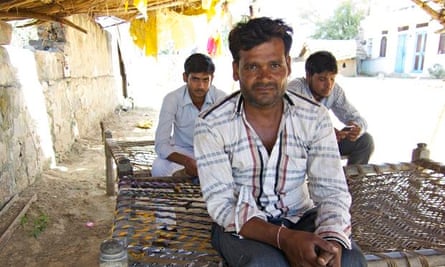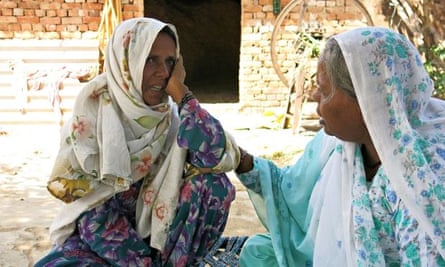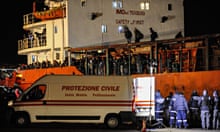Just 90 minutes’ drive from the thriving city of Gurgaon, near Delhi, a business hub in India and home to corporate giants Google and Microsoft, Hari Singh Yadav, landowner, farmer and eldest of seven brothers sits outside his front door and bemoans his bachelor status.
“There are not enough girls from my caste in our village, and I’m already 34 years old, so now no one wants to marry me,” he says. Only three of his brothers have found wives. “Here, if you don’t marry, people shun you. I want to go to [the southern city of] Hyderabad and get a wife but it will cost $1,500. Will you loan it to me?”
In the north-west of India, the business in brides is booming. Skewed sex ratios in states including Haryana, where there are only 830 girls for every 1,000 boys (pdf) and young women being lured away to jobs in India’s booming cities, means men like Yadav are increasingly left with few options when it comes to finding a wife.
“Among land-owning castes in rural areas, female foeticide is rampant because people bitterly oppose laws which say girls should inherit equally,” said Reena Kukreja, who teaches gender studies at Queens University in Ontario, Canada. “So they make sure daughters are never born.”

Nearly 50 years after the introduction of ultrasound technology, which campaigners say has led to the sex-selective termination of up to 10 million healthy female foetuses, families in search of wives are increasingly turning to traffickers to counter their sons’ diminishing marriage prospects.
There are no official statistics on trafficked and migrant brides in India, but according to a survey conducted across 1,300 villages in Haryana and Rajasthan by Queens University, there has been a 30% increase over the past three years in the numbers of women lured or coerced into marriage.
The UN Office of Drugs and Crime (UNODC) has identified organised bride trafficking rings increasingly operating in Haryana, Punjab and Uttar Pradesh, where gender ratios are among the least balanced in the country. A 2013 UNODC report (pdf) cites a survey of 92 villages in Haryana which shows that in 10,000 households, 9,000 married women had been bought from poor villages in other states.
The business of bride trafficking is proving so lucrative that local people are setting themselves up as dealers or brokers, sourcing women for families seeking partners for their sons.
Bashir, who refused to give his surname, is from Tijara in the north-western state of Rajasthan. He used to make his living harvesting crops or quarrying rocks. Now he supplements his meagre income by travelling to Assam twice a year – with his own purchased wife – to bring back brides for local village families.
“We tell them they’ll get good husbands here. We pay the families $70-100 [£45-65],” Bashir says, sitting outside his family home. “It’s a community service. We are poor, they are poor, so it’s a win-win situation.”
Yet the reality of these marriages for women bought and sold as brides is often a life of slavery and abuse. The UNODC says thousands of these women are raped, abused, used as domestic slaves and often eventually abandoned.
Sahiba was only 16 when a distant relative told her family in Assam that he could marry the poor teenager into a good home. He took her away, raped her twice and sold her as a bride to a family in Palwal, Haryana, 60km from the Indian capital Delhi. “I didn’t want to be raped again, so I went along with it,” she says. “And I thought it was a real marriage.”
She later discovered from her sister-in law that she had been bought for 13,500 rupees (£135) for her mentally ill husband, whom the family thought no one else would marry. “My blood began to boil and I decided to escape,” Sahiba says. “When I refused to sleep with my new husband, I was beaten and attacked with a knife. ‘We bought you,’ his family told me. ‘You have to obey.’”

Shafiq ur-Rehman is an activist and founder of Empower People, a charity that works with trafficked brides in 10 Indian states, including Haryana, where his offices have been set on fire and his employees shot at by locals. He says women who are bought and sold into marriage are often used as unpaid labourers. “It’s simple economics,” he says. “A local day labourer costs $140 for a season. But a girl only costs $100 for life. If it doesn’t work out, she can be resold and there’s no family nearby to help her. It’s no different from the former slave plantations of the US.”
Ghaushia Khan, 40, an activist, was sold into marriage in Haryana as a young woman and now provides legal aid to other trafficked brides. She says that, once sold, many women are considered worthless by the community they find themselves in. “In 1992, a [trafficked bride] in my neighbourhood was doused in kerosene and burnt alive,” Khan says. “Her skin began to peel off and I would hear her crying out, ‘please give me water’.”
Khan travels throughout Haryana trying to help these brides get access to legal support and assistance. She says few of the women she encounters are prepared to go to the police because they believe that, far from delivering justice, a complaint will leave them further isolated.
Some women, like Farida, have spent decades in villages far away from their families. Only 11 when, 20 years ago, she was sold to a 70-year-old man, her first experience of marriage was rape and violence. She gave birth to the first of seven children soon after. “That same day, I was ordered to get up and cook for everyone,” says Farida.
What is most painful, she says, is that her children have been taught to hate her. “My eldest son says to his grandmother, ‘Why don’t we sell her on? There are many others like her,’” she says. “What can I do? I don’t think I’ll ever see my sister again. I don’t even remember how to get back home.”

Others, like Sahiba, have managed to escape their marriages. Sahiba’s brother spent months tracking her down with the help of lawyers and activists with the Delhi-based Save the Childhood Movement. However, the chances of Sahiba getting any kind of justice or compensation are slim. Save the Childhood Movement estimates that, despite thousands of women being affected, there have been only two or three convictions a year for bride trafficking.
“There’s a very low conviction rate in cases of bride trafficking because the law is so fragmented,” says Rakesh Senger, an activist with the organisation. “One section deals with kidnapping, another with trafficking, another with rape, so cases usually took up to five years to prosecute. There is no inter-state police cooperation either, so it’s difficult to get victims to court to testify. However, with the new rape laws, we’re hopeful things will improve as cases have to be tried within a year.”
Ravi Kant, president of Shakti Vahini, one of India’s most high-profile anti-trafficking organisations, agrees. He says that, despite successfully bringing cases of forced labour – where they have prosecuted families for buying women from another state and forcing them into domestic servitude – they have persistently failed to bring cases of bride trafficking to court.
“We’ve tried to prosecute traffickers and men who’ve purchased wives in at least 20 different cases,” Kant says. “They stay in jail for two to three months, get bail and then either the prosecutor doesn’t actively pursue the case, or the victim never testifies because she’s afraid to face her tormentor again. The local police don’t see the accused as having committed any crime, so they don’t investigate properly, and they make no effort to cross state lines to bring victims to court.”
Sahiba’s future remains uncertain. She says that although she has been rescued, the end of her marriage means she can’t go home to her family. “I can’t go back because of the shame of leaving a husband,” she says.





Comments (…)
Sign in or create your Guardian account to join the discussion